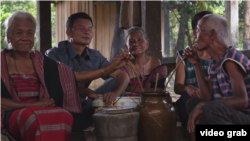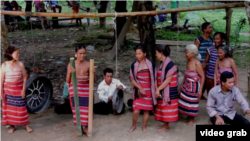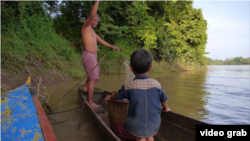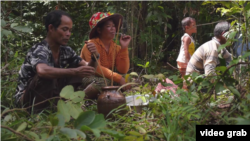A new documentary film about the daily lives of Cambodia’s indigenous minority groups launched last month detailing the struggles of the Khmer Loeu to cope with a shortfall of natural resources.
The 10-minute documentary, titled “Our Tribe - Our Heritage”, and funded by Save Cambodia’s Wildlife (SCW), documents the lives of four Cambodian “hill tribes”: the Brao, Kravet, Kreung and Khmer-Lao.
Cambodia is home to an estimated 300 distinct indigenous peoples from 24 ethnic minority groups, equal to about 2 percent of the country’s population.
Given the umbrella name Khmer Loeu, the majority of indigenous Cambodians live in rural areas in Ratanakkiri, Mondulkiri, Stung Treng, Kratie, Preah Vihear and Kampong Thom provinces.
As development in Cambodia continues apace, the Khmer Loeu face existential challenges to their way of life, as the forests they have depended on for centuries are decimated by agricultural and urban expansion.
Chan Vichet, project manager at SCW, said the loss of Cambodia’s forests not only impacted on the groups’ basic survival needs, but was also changing their culture and belief systems.
“They are losing their forest and it can affect their daily lives and culture. That is why SCW studied them and what the impacts are,” he said.
“They are losing their forest to illegal logging. It makes them worry that the spirits which [they believe] are living in the forest are angry. Their chickens will fall ill and their crops will perish.”
Many of Cambodia’s indigenous communities practice a form of animism, believing that the spirits of the forest watch over them, and have been subjugated historically by Cambodia’s lowland civilizations.
The Brao were forced into slavery by the Angkorian Empire, influencing how they farm the land and fish today. The Kravet are known for their intricate handicrafts, chin tattoos, teeth filing and harvest festival.
Like the Kravet, the Kreung is a Brao sub-group and well-known for their traditional weaving of krama scarves, traditional plate making and foraging prowess.
The Khmer-Lao, who migrated to Cambodia hundreds of years ago from the north, have survived largely by fishing and farming in the Mekong basin. With the construction of several large hydropower projects along the river’s tributaries, the Khmer-Lao’s way of life is threatened.
“We used to live in harmony along the river and our community depended on fishing. We do farming during the rainy season and fishing as a family during the dry season in-line with the Khmer-Lao tradition,” said Va Kham Phai, 64, a Khmer-Lao activist in Sre Pok Thom village, Ratanakkiri province.
Kham Phai had traveled from Ratanakkiri in Cambodia’s far northeast to Phnom Penh for the launch of the documentary and to express opposition to the loss of forestland and threats to traditional ways of life, such as the construction of the Lower Sesan II dam in Stung Treng province.
Yun Lorang, coordinator of the Cambodia Indigenous Peoples Alliance, said that economic development was pushing indigenous groups away from traditional ways of life.
“When land and natural resources are affected, so are our identities. Indigenous people’s identities are connected to land, natural resource, forest and rivers, where it is considered sacred to them,” he said.
Many indigenous peoples have fallen into debt as their traditional incomes have dried up.
Besides illegal logging, the Lower Sesan II, an $800 million project of the Hydro Power Lower Sesan 2 Company, a joint venture between Cambodia’s Royal Group, China’s Hydro Lancang International Energy and EVN International Joint Stock Company, a subsidiary of the Electricity of Vietnam, will have a significant impact on wildlife habitats, as well as taking up 24 percent of the total agricultural land in Sesan District.
The project will also have a severe impact on migratory fish stocks, creating a flooded area of 335 square kilometers, making it harder for the indigenous people to earn their primary and traditional source of income.
More than 9 percent of the fisheries in the entire Mekong River will be lost because of the Lower Sesan II, according to a report by the Proceedings of the U.S. National Academy of Science.
Kham Phai though not directly affected by the dam, said that he cannot generate as much income from fishing as he used to because the river’s flow has changed since the dam was built.
“The income from fishing for the upstream was cut off,” he said.
Houn Kalip, 60, a Brao community member, reported similar upstream impacts from the Lower Sesan II.
“For three years, there was not even a single fish here upstream,” he said “I can no longer fish. I used to get half to one kilogram of fish per day but now I cannot even get one [fish].”
“The new offered farmland is far from the village. Villagers cannot earn any income through fishing, or farming. Nothing. So they have to buy it in the market.” Kham Phai said.
“If [the forests and rivers] are not protected now, it will all be lost in the future” he said.










